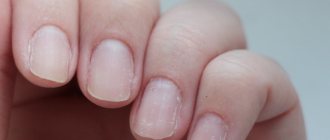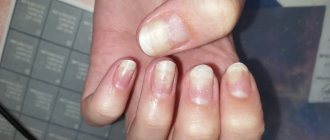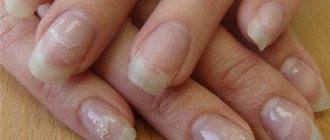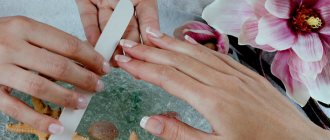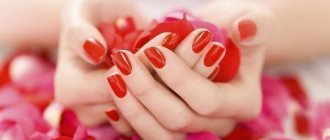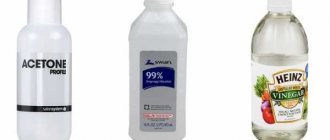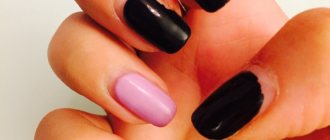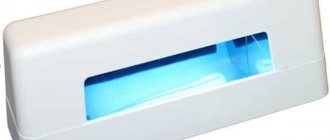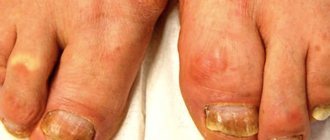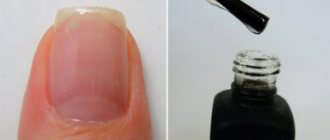For some reason, most girls try to restore their nails after gel polish using traditional medicine.
Something like this: After removing gel polish, nails are most often polished, due to this they become thin and vulnerable. Regular olive oil will help restore your nails and strengthen them. Warm it up to a comfortable temperature in the microwave or in a water bath, dip your fingers in the oil and keep them there for at least 10 minutes. Most likely, this happens because it is most convenient to restore nails with folk remedies at home.
I prefer to approach this issue from the point of view of common sense.
Have you ever wondered why our nails become unusable and have to be restored?
Why do some have healthy and strong nails, while others, on the contrary, are ashamed of theirs?
You can say long and hard that all people are different, with their own characteristics, etc. BUT! If we discard these arguments and put everything into perspective, it turns out that for most people with problem nails, everything started out very similar.
Nail restoration after gel polish and manicure prices. Where is the connection?
Nails often suffer when the master uses low-quality materials during work. First of all, this applies to the base coat. It is the base that comes into direct contact with the nail.
What materials do you think the craftsmen use who charge 500 rubles for their work? On cheap ones. Most likely these will be materials from AliExpress.
To be honest, I myself tried to use cheap materials a couple of times - after all, if you can’t see the difference, why pay more? It turned out there is a difference. Bluesky is a world famous “brand” (in quotes). That's what I experimented with. My experiment confirmed that after using cheap materials, nails need to be restored.
The base of cheap materials is very acidic, which is why it eats into the nail very deeply. Yes, the deeper the base penetrates into the nail structure, the stronger it will hold the gel polish on the nails. But! For the same reason, a cheap base dries our nails very much. After a couple of months, the nails become dry and begin to peel.
What materials do you think beauty salons use? Do not know? I'll tell you now.
Go to the beauty salon website and go to where the price list is written. There, in parentheses, they often write what material the master will work with. Most often it will be Shellac, Bluesky, Canny, or something else. In a separate article I wrote about the pros and cons of shellac.
It is profitable for beauty salons to use cheap materials, because the master needs to pay a salary, rent a place, and the salon owner needs a penny to fall into his pocket. And the fact that your nails may begin to peel over time is not a problem for the beauty salon. The salon will always be happy to sell you products for restoring your nails after gel polish.
Possible negative consequences after using gel coatings
So, let's look at the possible problems when using gel polishes.
- You were unlucky and you came across an inexperienced nail technician, or an overzealous one, and he filed down your nail plate almost to the state of tissue paper. Or perhaps the nail polish removal technology was not followed. Many people simply literally rip off the old coating with their “teeth”, removing the living fibers of the nail along with the varnish. And it also happens that the varnish turned out to be of poor quality or the nail was poorly degreased, and the coating peeled off the plate. And after 2-3 days you again ventured into the extension or coloring procedure. It turns out that the nail is cut down again and exposed to radiation in a lamp. As a result, you get thin nails, very sensitive to external influences, on which it is simply impossible to apply any coating. The plates react to even the slightest change in temperature.
- Another option is that you or your master uses low-quality cheap materials. As a result, the polish chips along with pieces of the nail, or the nail cracks right under the polish. The plate turns yellow, becomes covered with white spots and deep grooves appear. Nails become brittle, chip, peel, and break before they even have time to grow. It is impossible to reapply varnish on such nails; there is simply nothing for it to hold on to.
- Your nails were overexposed in the lamp, or extensions were done very often, and the nail polish removal technology was not followed. As a result, calloused formations have formed under the thinning plate, which stick out unsightly from under the nails, and it is impossible to process the free edge of the nail due to painful sensations when touching the growth. In addition, dark streaks of dried blood are visible under the nails. And the skin of the hands in the nail area peels and looks rough.
- The worst consequence is that the plate was literally cut down to the “meat” and instead of a beautiful manicure, there is an open, raw wound.
- Another unpleasant moment is the resulting fungus. It appears when disinfection rules are ignored and hygiene standards are violated.
It is in these cases that they talk about the need to restore nails.
Manicurist and nail restoration after gel polish.
Girls do not immediately begin to think about restoring their nails.
At first, nails are beautiful and healthy, and this is taken for granted. After several months (or even years) of regular trimmed manicures, removing gel polish with a file and acetone, small problems begin. The nails begin to peel a little, become brittle and dry. They try not to pay attention to this until the last moment... When nails already require treatment , everyone grabs their heads, goes into a search engine, and types in the phrase “ how to restore nails after gel polish .” After reading the recipes, they begin to frantically test everything they can on their nails.
First of all, you should take care of your nails, not the manicurist.
You need it more...
Manicurists who remove gel polish with a file and acetone calm their clients in every way. They are just used to working this way. They were taught this way in manicure courses. It is normal for them to see raised scales of the nail plate after working hard with a file with a coarse abrasive. Even if your nails look terrible, the last thing the nail technician will think about is your nails. After all, it is not beneficial for them to let their nails “rest.” Then you won't pay them for their work. You should think about this.
If you have noticed during the time that something is wrong with your nails, but have not yet reached the extreme stage, then the usual coating of your nails with gel polish may well help you. Yes yes, you heard right.
Nails should be coated with gel polish ONLY according to technology. A hardware manicure is required. You also need to remove the coating using a device.
If the master follows the technology of applying and removing the coating, then you will not have to think about restoring your nails after gel polish.
Believe me, gone are the days when beauty required sacrifice. If you do everything wisely, then there will be beauty, but sacrifices will not be necessary.
This is what nails look like after removing gel polish with a machine.
You know very well that gel polish is not just beautiful nails. The coating also perfectly protects against external damage - it “seals the nail” for several weeks. At this time, the nail can gradually begin to grow, and within a few months it can renew itself. Do you have an opinion that gel polish is harmful to your nails? Apply base coat only. This is what protects your nails. Gel polish performs only a decorative function.
I repeat that this method will only work if you realize it in time. If your nails begin to peel off a lot, the coating will not be able to adhere securely to the nail.
Below I have described effective restoration methods that can be used for very neglected nails.
If you regularly remove gel polish by soaking it in acetone, then sooner or later the following nail problems will appear:
- nails hurt, even from simply washing your hands in hot water;
- nails become thin and rough;
- delamination and fragility appear;
- nails become so soft that they can be bent like a piece of paper in all directions.
You can remove the coating with acetone only in the following cases:
- if you covered your nails with regular polish (not gel polish)
- if you covered your nails with Shellac, because it is a hybrid of gel and varnish. There, removal of the coating by soaking is provided for according to the technology.
You only need to remove classic gel polish with a device. This is if done correctly and using technology. Our masters like to “combine technologies” and change them in every possible way as they please. Then many people look for recipes for nail restoration.
I won't beat around the bush and say it straight:
Your nails are spoiled by a manicurist who does not remove the coating correctly.
This is the main reason why nails require restoration after gel polish. There is one more, but more on that below...
Treatment
Regardless of the form of onycholysis that occurs after using gel polish and the degree of its spread over a healthy surface, treatment should begin immediately to prevent progression of the damage.
Recovery should always begin with a consultation with a doctor. You can contact one of three doctors:
- Surgeon;
- Dermatologist;
- Pathologist.
If you know that the cause of detachments is not gel polish, but a fungal infection, then you can immediately consult a mycologist.
When visiting the hospital, the girl’s manicure area is examined, and sometimes tests are prescribed to determine the degree of development of the disease and the presence of pathogenic microflora that provokes tissue inflammation. Based on the results of the tests, treatment is prescribed.
Since it is not recommended to apply gel polish during the recovery period, it is worth paying attention to complex therapy. It will help restore the structure of the manicure faster and you will return to visiting the nail service specialist.
Complex therapy usually consists of several treatment methods: using or taking medications, following traditional recipes and observing proper hand care.
If pathogenic bacteria have penetrated the plate, it is important to pay attention to the intake and application of antifungal agents:
- External - Lotseril, Lamisil, Exoderil, Mikozan.
- For oral administration – Pimafucin, Nystatin.
For initial and active forms of lesion development, only external medications are prescribed. To eliminate the advanced form, you first need to relieve the inflammatory processes, for which antimycotics are used.
The affected plate itself must be periodically trimmed or filed as the free edge grows. Also pay attention to its daily treatment with antiseptic agents to prevent the progression of onycholysis. Hydrogen peroxide or special alcohol-based products can be used as an antiseptic.
To speed up the recovery period for natural manicure, pay attention to increasing local immunity and accelerating metabolism. For this, one of the drugs is used - Panthenol or Bepanten.
It is additionally recommended to use folk recipes that will additionally care for the sensitive surface:
- Salt baths. To eliminate pathogenic microflora and restore the surface structure, dissolve 3 tablespoons of sea salt and 2 tablespoons of baking soda in a liter of water. Immerse your hands in the warm solution for 15 minutes, and then wipe dry with disposable paper towels without rinsing;
- Compress with onions. Finely chop the onion into a paste and strain, leaving only the juice. After this, mix aloe, onion and lemon juice in equal proportions. Soak gauze folded several times in the healing liquid and apply it to your finger, tightly fixing the compress with an adhesive plaster for half an hour;
- Treatment with iodine or lemon juice. Every day it is recommended to wipe the entire plate and cuticle area with iodine solution or freshly squeezed lemon juice to gradually restore the structure of the nail;
- Lotions with chicken protein. To do this, break the egg and separate the white, placing it in a narrow glass. Gradually pour in the alcohol, stirring thoroughly until white clots begin to form. After this, strain the liquid, soak a cotton pad in it and apply it to the nail until dry.
You need to use traditional recipes every day, since long breaks can reduce the effectiveness of natural manicure treatment, which is why the girl will have to use medications longer.
Additionally, during rehabilitation, the girl is prescribed recommendations for hand care, which include preventing relapse. You should also follow the advice as a preventive measure after finishing treatment:
- When treating nails, first disinfect the tools you use and use them carefully without damaging the skin.
- When performing household work for which you use chemicals containing aggressive components, wear protective rubber gloves.
- Before applying gel polish, make sure there is no allergic reaction to it. To do this, you first need to distribute it over one nail and leave it for a day.
- When working with metal and wood, use thick protective gloves to prevent the introduction of splinters.
- If there is mechanical damage to your fingers or hands, treat the area with hydrogen peroxide and apply a sterile bandage to prevent infection from entering the open wound.
It is recommended to apply essential oil to the cuticle every day before bed and massage it in. This way you will speed up the metabolism in tissues and increase the local immunity of your fingers.
Where to start restoring your nails
I recommend first understanding where nail problems come from, and why they need to be restored? By and large, there are only two options:
- Nails are damaged due to improper removal of gel polish
- Nails are damaged due to problems in the body.
I will dwell in detail on the first point - when problems with nails arose due to the removal of gel polish. If problems with nails are not related to manicure and removal of gel polish, then medical treatment of the body, not the nails, is needed. But today we are not talking about that.
Restoring nails using traditional methods does not work.
On Google you can find a bunch of wonderful stories of how many girls restored their nails after gel polish with sea salt, soda, iodine, yolk (hehe), and other food products.
Looking ahead, I want to say right away - this does NOT work.
Why does not it work? Yes, because nails are dense, keratinized plates. After improper removal of the coating, the nail plates rise like a fur coat, and the nail looks rough to the touch and thin. How can sea salt or oak bark decoction smooth out raised scales? No way.
To make it clearer, I’ll draw an analogy with wallpaper.
Wallpaper is washable, you can paint it, wash it, and then paint it again. Imagine that you have wallpaper on your hands instead of nails. After several careless color changing procedures, a piece of wallpaper has fallen off, what do you do? Apply glue and glue. No one would even think of making poultices from herbs or making an iodine mesh for wallpaper))).
The example with wallpaper may be crude, but it fully explains the essence of the issue. By the way, the main idea of restoring split nails is to try to stop further splitting and at the same time “glue” the split plates together. How this is written is described below.
- “Well, let’s say, you say, but what about these reviews”:
Everything is very simple here. If you smear the nail plate for 2-3 months with water, iodine, smart enamel, or something else, then only one thing will happen to the nail - it will grow back. It's like applying plantain to a broken arm. The effect will be the same) If you apply it and don’t disturb it for a couple of months, you’ll see that the bone will heal.
Or you can do nothing and the result will be the same.
Effective methods of nail restoration
But seriously, the following might help:
IBX System is a system for restoring the nail plate. The peculiarity of the composition is that it firmly adheres to the nail itself and penetrates deeply into its structure, unlike traditional products, which only create a layer on top. After application, it will not be possible to remove the coating from the nail due to the deep penetration of the product into the nail. The protective layer simply grows along with the plate and is gradually cut off. This is exactly the same product that “glues” the separated nail plates together.
How it works The IBX System consists of two different tools. They only work in combination; applying them separately makes no sense. The first 9.5 ml bottle is called IBX Repair. It must be applied in one layer. It instantly enters the structure of the nail, filling damage and cracks invisible to the naked eye. You will notice the therapeutic effect immediately after the first use - the bumps will disappear, the color will become even and healthy, the yellowish tint and stains will disappear. The second bottle has a larger volume - 14.3 ml, since it is recommended to apply it in two layers. This product is designed to strengthen nails. After using it, they begin to grow faster. IBX acts like “double-sided tape,” allowing damaged areas to be sealed. As a result, it creates a protective layer and helps reduce white spots that may appear when using nail gel.
IBX acts like “double-sided tape,” allowing damaged areas to be sealed. As a result, it creates a protective layer and helps reduce white spots that may appear when using nail gel. Detailed instructions that I liked:
Polishing your nails with wax is the second effective way to restore your nails.
The essence of the procedure is applying wax to the nail and then polishing it with a soft polisher.
Wax creates a protective film on the surface of the nail, which helps retain moisture inside and protects from external influences. The beneficial microelements of wax also care for the nail plate and help strengthen it.
The technique is very simple, first a manicure is performed, then with a file or buff of 250 - 300 grit, soft sanding is performed against the growth of the nail. This removes the moisture released by the plate. This will help the new insulation layer develop much faster. In addition, it is at this stage that all unevenness and yellowing are removed. Next, wax is applied to the nail.
A drop of wax is applied to the plate itself, which is rubbed both into the nail itself and into the skin around it. The surface is treated with a special polishing file 1000 - 1200 grit until the finger glides easily. Waxing your nails is completed with a protective polish and cuticle oil. I recommend wax from DNC or Nordic Flora to my clients
Another way to restore nails
Nails are restored when the nail plate is renewed. The faster the new nail grows, the faster we will solve our problems. Nail growth needs to be stimulated. There is no shamanism in this either. It is enough to balance your diet and take vitamins.
Apply cuticle oil. The nail itself is keratinized tissue, but everything around it and under it is quite alive. The cuticle also needs care - this time. Under the nail is the nail bed, which is supplied with blood - that's two. When you rub cuticle oil in, you solve two problems at once:
- Take care of your cuticle.
- Massage the nail, which leads to improved blood circulation in the nail bed.
This stimulates nail growth.
Here's one more thing: All the nail restoration methods that I described are quite suitable for use at home.
IBX can be purchased at any professional store. It's even easier to polish your nails with wax - it's sold at the pharmacy.
Although I’m not a supporter of any nail procedures at home, I’ll probably make an exception for IBX and waxing
